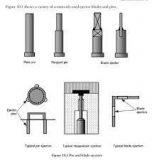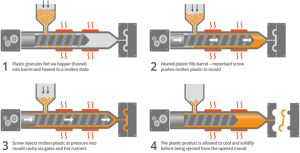Injector pins are an essential part of your engine’s performance. They regulate the fuel flow to ensure the engine runs smoothly and efficiently. However, like any other component, injector pins can fail over time, which can lead to poor fuel economy and even engine failure.
Click Here to Read Part 1st
Fuel Leaks and Poor Fuel Economy:
Injector pins are an important component of your vehicle’s fuel system, responsible for delivering fuel to the engine. Over time, injector pins can become faulty and lead to a range of problems. Signs of faulty injector pins include fuel leaks and poor fuel economy. Other symptoms may include rough idling, reduced power, or black smoke from the exhaust.
Replacing injector pins is a delicate process that requires careful attention to detail and following a step-by-step guide. It’s important to use the correct tools and follow safety precautions during the replacement process. By mastering the art of injector pin replacement, you can ensure that your vehicle’s fuel system runs smoothly and efficiently, without any unnecessary leaks or performance issues.
Tools Required for Injector Pin Replacement:
Replacing an injector pin requires a few specific tools to ensure that the job gets done properly. The required tools vary depending on the make and model of the engine, but in general, you will need an injector removal tool to remove the old injector from the engine. You will also need a pin removal tool to remove the old injector pin and a new injector pin to replace it.
Lubricant is helpful during the installation process since it eases the insertion of the new injector pin. Lastly, a torque wrench is necessary to tighten the injector and ensure it’s installed correctly. Having these tools at hand not only makes replacing an injector pin easier but ensures that you don’t damage any parts of your engine while doing so.
Step-by-Step Guide for Injector Pin Replacement:
Replacing an injector pin can be a daunting task, but with the right tools and knowledge, it can be done easily. Before starting, make sure you have all the necessary tools and safety equipment. The next step is to carefully remove the old injector pin without damaging any surrounding components. Once removed, clean the area thoroughly to prepare for the new injector pin installation.
Carefully install the new injector pin and ensure it is securely in place before testing its function and performance. Remember to follow proper safety precautions when working on your engine, such as disconnecting the battery and wearing protective gear. With this step-by-step guide, you can master the art of injector pin replacement and keep your engine running smoothly.
Click Here to Read Part 1st
Removing the Fuel Rail and Injector Pins:
Replacing injector pins can be a complex process that requires careful attention to avoid damaging the engine or surrounding components. Here is a step-by-step guide to help you get started:
- Begin by removing the fuel rail, which is the metal bar that connects all of the injectors together. This will give you access to each individual injector.
- Next, disconnect the electrical connections to each injector by gently pulling on them until they come loose.
- Use a special tool, such as pliers or a socket wrench, to carefully remove each injector pin from its socket. Be sure not to damage any of the surrounding components while doing so.
- Once you have removed all of the old pins, clean each socket and pin thoroughly with a wire brush or other appropriate tool.
- Install the new pins one at a time, making sure they are securely in place.
- Reconnect all electrical connections and fuel lines carefully, making sure everything is properly seated and tightened.
- Test for leaks before starting the engine to ensure that everything is working properly.
By following these steps carefully and taking your time with each step, you can successfully replace your injector pins without causing any damage or other issues with your engine.
Inspecting the Injector Pins and Replacing Faulty Ones:
Injector pins are a crucial part of a diesel engine’s fuel system and need to be regularly checked for signs of wear and tear. A visual inspection of the injector pins can help identify any faulty ones that require replacement.
Replacing injector pins involves removing the fuel injectors, removing the old pins, and installing new ones in their place. It’s important to ensure that the new pins are installed correctly and tightened to the appropriate torque specifications to prevent any future issues.
Following these step-by-step procedures for injector pin replacement can help prevent serious damage to your engine. By inspecting and replacing faulty injector pins, you can maintain your diesel engine’s performance and prolong its lifespan.
Click Here to Read Part 1st
Conclusion:
Injector pins play a crucial role in ensuring your engine performs at its best. A faulty injector pin can lead to fuel leaks and poor fuel economy, affecting the overall performance of your vehicle. However, with the right tools and knowledge, replacing injector pins can be done easily.
Follow our step-by-step guide to ensure a successful replacement, starting with removing the fuel rail and inspecting the injector pins for faults. By mastering the art of injector pin replacement, you can save yourself from costly repairs and ensure your engine runs smoothly.
 Mastering the Art of Injector Pin Replacement: A Step-by-Step Guide – Part 1
Mastering the Art of Injector Pin Replacement: A Step-by-Step Guide – Part 1  Injection Molding Ejection System: Where to Use Ejector Pins and How to Design Ejection System
Injection Molding Ejection System: Where to Use Ejector Pins and How to Design Ejection System  A Step-by-Step Guide to the Injection Molding Process
A Step-by-Step Guide to the Injection Molding Process  Plastic Injection Mold Material Guide – Advantages & Applications Of 20 Common Injection Molding Materials
Plastic Injection Mold Material Guide – Advantages & Applications Of 20 Common Injection Molding Materials